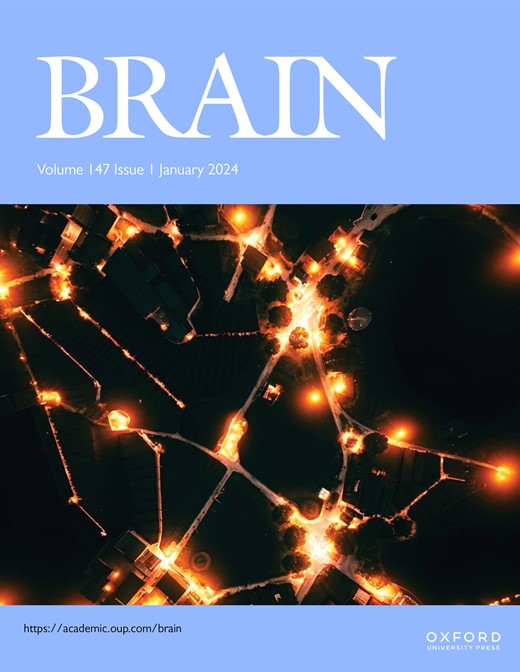老年海马硬化的常见神经病理改变驱动因素
IF 10.6
1区 医学
Q1 CLINICAL NEUROLOGY
引用次数: 0
摘要
海马老化硬化(HS-A)是一种神经病理改变(NC),影响多达20%的老年痴呆症患者。HS-A的病因是异质性的,但HS-A与边缘显性年龄相关性TDP-43脑病NC (LATE-NC)密切相关。其他nc也与HS-A有关,但这些关联在以前的研究中并不一致。此外,由于LATE-NC和HS-A密切相关,因此在检查其他nc和HS-A之间的关联时,调整LATE-NC是很重要的。本研究的目的是在调整LATE-NC之前和之后,检查其他常见nc与HS-A的关系。我们分析了国家阿尔茨海默病协调中心(NACC)神经病理学数据集,并检查了阿尔茨海默病NC (ADNC)、路易体(LB)和脑血管NC与HS-A的关系,并以多种方式调整了LATE-NC。我们使用贝叶斯多水平逻辑回归模型对有序预测因子进行单调建模,并报告了所选模型和预测因子水平的比值比(OR)或水平间平均OR (aOR)以及95%可信区间(CI)以及HS-A的预期频率。在n=1933名尸检参与者中(死亡时平均年龄83岁,51.3%为女性),278人(14.4%)存在HS-A。晚期nc与HS-A密切相关(aOR=3.7, 95% CI=[2.8, 5.0])。在不包括LATE-NC作为预测因子的模型中,ADNC显示出与HS-A的适度关联(aOR=1.4, CI=[1.1, 1.8]),但在调整LATE-NC后,这种关联减弱(aOR=1.11, CI=[0.9, 1.5]);与adnc相关的A/B/C评分和边缘lb的结果相似。然而,几种脑血管NCs同样与HS-A相关,两者均未调整LATE-NC(动脉粥样硬化aOR=1.4,小动脉硬化aOR=1.6,白质稀疏(WMR) aOR=1.4)和调整LATE-NC(动脉粥样硬化aOR=1.4,小动脉硬化aOR=1.5, WMR aOR=1.3)。在一个联合模型中,LATE-NC与HS-A密切相关,但整体脑血管nc、APOE-ε4(增加的几率)和教育(减少的几率)也与HS-A相关。预测无晚期NC或整体脑血管NC水平的HS-A频率为1.5% (CI=[0.6%, 3.1%]),而预测晚期NC 3期和严重脑血管NC水平的HS-A频率为94.5% (CI=[84%, 99.5%])。晚期nc可能是HS-A的最重要原因。虽然ADNC似乎通过其与LATE-NC的关联与HS-A相关,但脑血管与HS-A的关联独立于LATE-NC,强调了血管因素在HS-A病因学中的重要性。本文章由计算机程序翻译,如有差异,请以英文原文为准。
Common neuropathologic change drivers of hippocampal sclerosis of ageing
Hippocampal sclerosis of aging (HS-A) –severe cell loss and gliosis in the hippocampal formation– is a neuropathologic change (NC) that affects up to 20% of elderly persons with dementia. The etiology of HS-A is heterogeneous, but HS-A is strongly associated with limbic-predominant age-related TDP-43 encephalopathy NC (LATE-NC). Other NCs have also been implicated in relation to HS-A, but these associations have been inconsistent across previous studies. Also, because LATE-NC and HS-A are so strongly associated, it is important to adjust for LATE-NC when examining associations between other NCs and HS-A. The goal of this study was to examine associations of other common NCs with HS-A, both before and after adjusting for LATE-NC. We analyzed the National Alzheimer’s Coordinating Center (NACC) neuropathology dataset and examined associations of Alzheimer’s disease NC (ADNC), Lewy bodies (LB), and cerebrovascular NCs, with HS-A, adjusting for LATE-NC in multiple ways. We used Bayesian multilevel logistic regression models with monotonic modeling for ordinal predictors, and report the odds ratios (OR) or average OR across levels (aOR) along with 95% credibility intervals (CI) as well as expected frequencies of HS-A for selected models and predictor levels. Of n=1933 autopsy participants included (average age at death of 83 years, 51.3% women), HS-A was present in 278 (14.4%). LATE-NC was strongly associated with HS-A (aOR=3.7, 95% CI=[2.8, 5.0]). While ADNC showed a modest association with HS-A in models where LATE-NC was not included as a predictor (aOR=1.4, CI=[1.1, 1.8]), this association was reduced when adjusting for LATE-NC (aOR=1.11, CI=[0.9, 1.5]); results were similar for the ADNC-related A/B/C scores and limbic LBs. However, several cerebrovascular NCs were similarly associated with HS-A both without adjusting for LATE-NC (atherosclerosis aOR=1.4, arteriolosclerosis aOR=1.6, white matter rarefaction (WMR) aOR=1.4) and with adjusting for LATE-NC (atherosclerosis aOR=1.4, arteriolosclerosis aOR=1.5, WMR aOR=1.3). In a combined model, LATE-NC was strongly associated with HS-A, but global cerebrovascular NCs, as well as APOE-ε4 (increased odds), and education (decreased odds), were also associated with HS-A. Predicted HS-A frequency for predictor levels of no LATE-NC or global cerebrovascular NCs was 1.5% (CI=[0.6%, 3.1%]), while it was 94.5% (CI=[84%, 99.5%]) for LATE-NC stage 3 and severe global cerebrovascular NC levels. LATE-NC is likely the most important cause of HS-A. While ADNC seems to be associated with HS-A through its association with LATE-NC, the association of cerebrovascular with HS-A independent of LATE-NC underlines the importance of vascular factors in the etiology of HS-A.
求助全文
通过发布文献求助,成功后即可免费获取论文全文。
去求助
来源期刊

Brain
医学-临床神经学
CiteScore
20.30
自引率
4.10%
发文量
458
审稿时长
3-6 weeks
期刊介绍:
Brain, a journal focused on clinical neurology and translational neuroscience, has been publishing landmark papers since 1878. The journal aims to expand its scope by including studies that shed light on disease mechanisms and conducting innovative clinical trials for brain disorders. With a wide range of topics covered, the Editorial Board represents the international readership and diverse coverage of the journal. Accepted articles are promptly posted online, typically within a few weeks of acceptance. As of 2022, Brain holds an impressive impact factor of 14.5, according to the Journal Citation Reports.
 求助内容:
求助内容: 应助结果提醒方式:
应助结果提醒方式:


